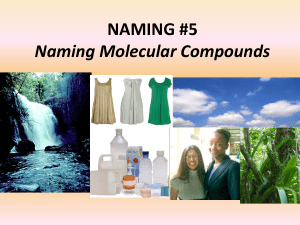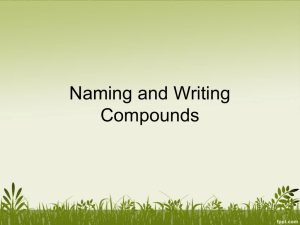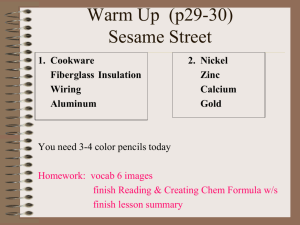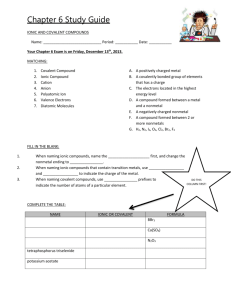Chemical Compounds
advertisement
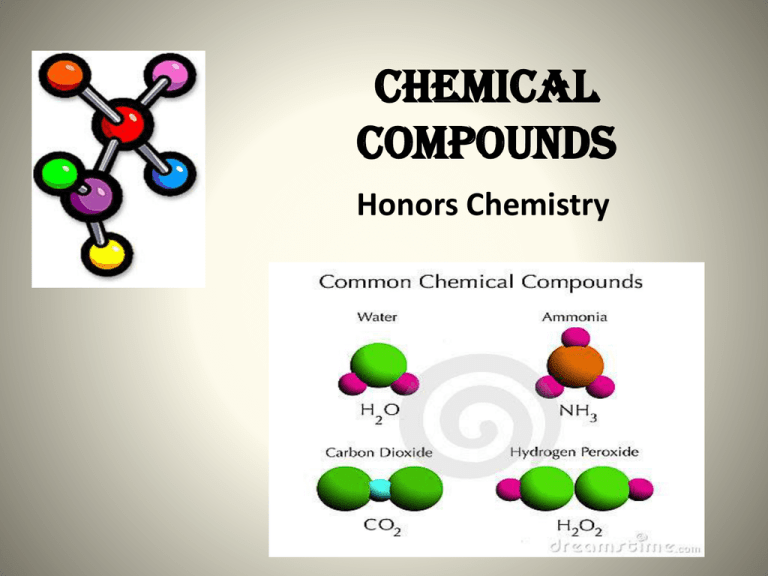
Chemical Compounds Honors Chemistry 3 Types of Formulas • Empirical: Smallest whole-number-ratio of atoms or ions in a compound – Ex. CH2 NH3 • Molecular: Tells you the actual number of atoms of an element in a compound – Ex. C2H4 N2H6 • Structural: Indicates how the atoms are bonded to each other How does the mole relate to compounds? REMEMBER Atoms are too small to count or mass individually. It is easier to count many or mass many. amu gram (atomic scale) (macroscopic scale) mole atoms, ions, molecules, or formula units Molar Mass = mass, in grams, per 1 mole of a substance units = grams/mole (g/mol) Example: the molar mass of H2O is 18.0 g/mol Molecular formulas and molar masses are used to determine Percent Composition 1. Definition: percentage, by mass, of each element in a compound % Composition = (part/whole) x 100 2. Problems a. Calculate the % composition of NaCl % Na: 39.3% Na % Cl: 60.7% Cl Percent Composition of Hydrate Definition: A hydrate is an ionic compound with water embedded in it. b. Calculate the % water in a hydrate, Mg3(PO4)2 . 6H2O. 370.9 g/mol Mg3(PO4)2 . 6H2O molar mass of hydrate = molar mass of anhydrate + x(molar mass of water) % water = 29.1% H2O How can you identify different types of compounds? • Type of Compound Identification • Ionic Begins with a metal • Covalent Begins with a nonmetal • Acid Begins with a hydrogen and is aqueous • Hydrate Ionic Compound and Water Ionic Compounds • Made from a positively and negatively charged ion • Overall charge of the compound is zero • Types of Ionic Compounds – Binary – Ternary Binary Compounds: Composed of two monatomic ions • Primary Rules for Charges: YOU MUST KNOW THESE RULES 1 or IA +1 2 or IIA +2 3 or IIIA +3 15 or VA -3 in binary compounds with metals, H, or NH4+ 16 or VIA -2 in binary compounds with metals, H, or NH4+ 17 or VIIA -1 in binary compounds with metals, H, or NH4+ Ionic Compounds – look at charges; roman numerals needed for elements with more than one charge (polyvalent) a. Binary Compounds – only monatomic ions in compound sodium chloride NaCl iron(III) sulfide Fe2S3 FeS iron(II) sulfide Ionic Compounds Binary Compounds HF(g) hydrogen fluoride AlCl3 aluminum chloride Cr2O3 chromium(III) oxide Ionic Compounds Ternary Compounds – contain 1/more polyatomic ions in compound sodium carbonate Na CO 2 3 chromium(III) oxalate Cr2(C2O4)3 ammonium sulfate (NH4)2SO4 Ionic Compounds • Ternary Co3(AsO4)2 CuSO3 cobalt(II) arsenate copper(II) sulfite Note for polyatomic ions: -ate vs. –ite per- and hypo- Ionic Compounds • magnesium hydroxide • calcium sulfate • ammonium phosphate Mg(OH)2 CaSO4 (NH4)3PO4 Anion Description Example per_____ ate 1 extra oxygen ClO4-1 perchlorate _______ate the most common form ClO3-1 chlorate _______ ite 1 less oxygen ClO2-1 chlorite hypo_____ ite 2 less oxygens ClO-1 hypochlorite Now try these… • sulfite SO3-2 • periodate IO4-1 • phosphite PO3-3 • bisulfite HSO3-1 Check for Understanding • magnesium hydride • calcium acetate MgH2 Ca(CH3COO)2 • FeS2O3 iron (II) thiosulfate • SnI4 tin (IV) iodide Molecular Compounds – formed between 2 nonmetals *Use prefixes mono = 1 di = 2 tri = 3 tetra = 4 penta = 5 hexa = 6 hepta = 7 octa = 8 nona = 9 deca = 10 Binary Compounds: only 2 elements in the compound; use prefixes and –ide ending CCl4 carbon tetrachloride N2O5 dinitrogen pentoxide More Practice • dihydrogen monoxide • nitrogen tetrabromide • S2O6 H2O NBr4 disulfur hexoxide Hydrates – ionic compound with water bonded in its structure anhydrate . xH2O • anhydrate ionic compound • add prefix to indicate # of water molecules CuSO4 . 5H2O copper(II) sulfate pentahydrate Acids – compounds that produce hydrogen ions in water 1. Mineral Acids Binary Acids 1st word: prefix = hydro root formed from anion suffix –ide changed to -ic 2nd word: acid a. HCl(aq) HBr(aq) hydrochloric acid hydrobromic acid B. Oxyacids • 1st word: root from anion Suffix ate changed to ic Suffix ite changed to ous **Exceptions: if you have sulf or phos as roots, change the root to sulfur or phosphor • 2nd word: acid HNO3 HNO2 phosphorous acid Nitric acid Nitrous acid H3PO3 Common Acids to Know • • • • • • • hydrochloric acid HCl carbonic acid H2CO3 perchloric acid HClO4 sulfuric acid H2SO4 phosphoric acid H3PO4 nitric acid HNO3 CH3COOH = HC2H3O2 acetic acid Salts • Ionic compound composed of a cation (positive ion) and an anion (negative ion) from an acid • • • • NaCl CaSO4 NaHCO3 NaHSO3 Organic Compounds • >11 million compounds • Contain a C-C or C-H bond in combination with N, O, S, P or halogens • Simplest = CH4 • Most complex = DNA Hydrocarbons • Only have carbon and hydrogen • Simplest organic compounds • From petroleum (crude oil) Organic Compounds Allotropes of carbon Allotropes: Different forms of an element in same physical state Catenation: ability of an element to form chains and/or rings of covalently bonded atoms Structural Formula • Indicates the number and types of atoms present in a molecule and also shows the bonding arrangement of the atoms • One possible isomer of C4H10 • Does not show 3D shape Naming Organic Compounds • Alkanes – saturated organic compound – Contains only single bonds – General Formula: CnH2n+2 • Alkenes – unsaturated organic compound – Contains at least one double bond – General Formula: CnH2n • Alkynes – unsaturated organic compound – Contains at least one triple bond – General Formula: CnH2n-2 • What type of organic compound is C4H10 ? Naming Hydrocarbons 1. Find the longest chain of carbon atoms. Choose the base name that describes the number of carbon atoms in this chain. Use the following endings: Alkane (ane), Alkene (ene), Alkyne (yne) # C atoms Stem # C atoms Stem 1 meth 9 non 2 eth 10 dec 3 prop 11 undec 4 but 12 dodec 5 pent 13 tridec 6 hex 14 tetradec 7 hept 15 pentadec 8 oct 16 hexadec Naming hydrocarbons 2. Number the carbon atoms in this longest chain beginning at the end nearest the 1st branching. • If there is branching at equal distances from both ends of the longest chain, begin numbering at the end nearest the branch that is 1st in alphabetical order. 1 2 3 4 Naming Alkenes and Alkynes • Number the carbon atoms in the chain sequentially, beginning at the end nearer the double or triple bond. If the parent chain has more than 3 carbons, insert the number describing the position of the double or triple bond (indicated by its 1st carbon location) before the base name. 1-butene 2-butene Branches/Substituents on the Main Chain 1) Additional Hydrocarbon branches The hydrocarbon branches are called alkyl groups: -CH3 methyl -CH2CH2CH3 propyl -CH2CH3 ethyl -CH2CH2CH2CH3 butyl 2)The organic halides are elements from group 17 in the periodic table. The prefix can be fluoro-, chloro-, bromo- or iodo-. Hydrocarbon Branches or Substituents Assign the name (stem with yl ending) & position number to each substituent or branch. Arrange substituents in alphabetical order. The hydrocarbon branches are called alkyl groups: -CH3 methyl -CH2CH2CH3 propyl -CH2CH3 ethyl -CH2CH2CH2CH3 butyl Naming hydrocarbons 4. Use the appropriate prefix to group like substituents: di = 2, tri = 3, tetra = 4, etc. Do not use these prefixes when alphabetizing attached groups 5. Write the name as a single word. Use hyphens to separate numbers & letters and commas to separate numbers. Do not leave any spaces. Naming Alkenes and Alkynes In naming alkenes and alkynes, the mulitple bond takes positional precedence over substituents on the carbon chain. The double bond is assigned the lowest possible number. 3,3-dimethyl-1-butene 4-methyl-2-pentene Naming Organic Halides (Alkyl Halides) • The organic halides are named as halo- derivatives of the parent hydrocarbon. The prefix can be fluoro-, chloro-, bromo- or iodo-. 1-chloropropane 1-chloro-2-methylpropane http://wps.prenhall.com/wps/media/objects/476/488316/index.html Alkene Examples 3,4-dimethyl-3-hexene 3-ethyl-4,6-dimethyl-1-heptene Naming Alkynes • Named just like the alkenes except the suffix –yne is added ethyne 1-butyne propyne 2-butyne Alkyne Examples 3-methyl-1-butyne 5-methyl-2-hexyne Arrangement of Atoms • Isomers – compounds that have the same molecular formula but different structures Isomers of C6H14 • More C atoms in formula, more isomers – 18 isomers for C8H18 – 35 isomers for C9H20 – 75 isomers for C10H22 Structural Isomers • Isomers in which the atoms are bonded together in different orders. • C4H10 (note continuous chain of C atoms) butane methylpropane Physical Properties of Structural Isomers Melting Point (°C) Boiling Point (°C) Density at 20°C -138.4 -0.5 0.5788 -159.4 -11.633 0.549 Butane Methylpropane Ex #1) Butane, C4H10 ISOMERS Ex #2) Butene, C4H8 Ex #3) 2-Butene, C4H8 Ex #4) methyl propene, C4H8 Functional Groups an atom or group of atoms that is responsible for the specific properties of an organic compound Diffusion and Effusion Diffusion: the mixing of molecules of 2 or more gases due to their molecular motion (spontaneous) Effusion is the movement of gas atoms or molecules through a small opening. Gases confined in a container randomly pass through a tiny opening in the container. ex) hole in a tire; soda bottle (CO2 escaping) Graham’s Law: The rate of effusion of a gas is inversely proportional to the square root of its molar mass. He and SF6 demo
